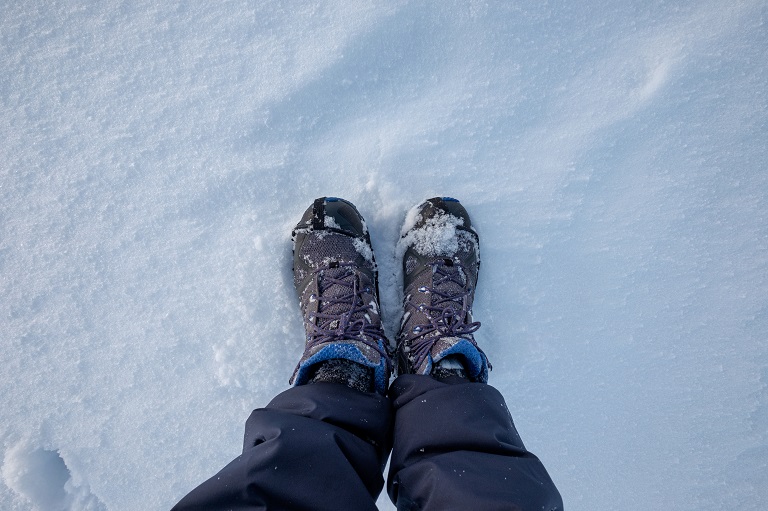Using Ice Cleats In The Winter? Here Are Five Pros And Cons

If you live where it snows, you may already have considered using ice cleats to walk around safely. Ice cleats give you traction on slippery surfaces like snow, but they’re not always the best choice for everyone. In this article, we will discuss the best tips for walking on ice. Here are five pros and cons of using ice cleats:
When To Use Ice Cleats
Ice cleats are a good option for ice walkers for shoes, but you shouldn’t use them on dry surfaces. You can use them on a variety of shoes, including your favorite pair of sneakers.
Ice Cleats Are For Short-Term Use.
Ice cleats are not for long periods. You should only wear them when you need them and not continuously for more than a few hours. If you plan to do this, the ice cleat can become damaged from use and cause injury.
They Are Difficult To Walk On Hard Ground.
It can be challenging to walk in ice cleats on hard ground. You may get away with wearing them indoors, but going outside on pavement or other hard surfaces can be hard. If there are any cracks, you could easily slip as easily as if you weren’t wearing them.
They Aren’t Waterproof.
While ice cleats are a great way to keep you from slipping and falling on slick surfaces, they’re not waterproof. If it rains or the road is wet, water can get into your cleats and make them heavy and awkward to walk in. Water also makes the rubber more slippery than when dry, which can be dangerous if you’re trying to cross an icy sidewalk or driveway.
They Can Be Annoying To Put On And Take Off.
If you decide to use them, mind that they can be annoying to put on and take off. And once you do have them on, they can restrict your range of motion, making it really hard to do some of your regular activities that require bending or squatting.
Best Tips For Walking On Ice.
One of the best tips for walking on ice is using a traction agent. For immediate traction, you can also choose traction agents like Walk on Ice.
Walk on Ice is 100% natural and provides increased traction for walking on ice. You can also use it on your car tires if your car gets stuck in snow or not climbing on your inclined driveway.
Takeaway: Hope you liked these ice safety tips. Ice cleats are great for providing more traction on slippery surfaces and preventing falls in the winter months when it’s cold outside (or even when there is snow). However, using a good traction agent is an unbeatable solution.
Get ready for winter with Walk On Ice instant traction on snow and ice
How Thick Must Ice Be To Walk On Safely?
Even if you’ve got ice cleats or traction agents on your side, many people wonder: how thick must ice be to walk on without worrying about breaking through? The general guideline is at least 4 inches of solid, clear ice for one person walking. Less than that is risky, because ice doesn’t freeze evenly—it can be thick in one area and dangerously thin just a few steps away.
For group activities, skating, or winter gear, even more thickness is required. Snowmobiles, for example, need 5–7 inches, and light cars require 12–15 inches. The takeaway? Never trust the ice just by looking at it. Test thickness frequently, especially when temperatures fluctuate. Walk On Ice helps with traction above the surface, but beneath the surface, safety still depends on solid, reliable thickness.
What Can You Use Cat Litter For In Winter?
Another question that comes up every season: what can you use cat litter for once snow and ice take over? Some people scatter it across their driveway, hoping for grip. While cat litter can provide a little traction because of its grit, it has downsides. Traditional clay litter can clump when wet and freeze into slippery patches, which defeats the purpose.
However, cat litter isn’t entirely useless in winter. You can keep a bag in your trunk as emergency weight over the rear axle (great for rear-wheel drive cars), and in a pinch, sprinkle some near your tires if you’re stuck. That said, it’s not the best kitty litter for ice traction compared to dedicated traction agents. Walk On Ice, for example, is designed specifically to grip icy surfaces instantly, without leaving the mushy mess cat litter often creates.
How To Not Get Stuck In Snow
Ice walking isn’t the only challenge winter throws at you—cars getting stuck in snow is just as common. So how do you make sure you’re not spinning your wheels endlessly? First, always carry a small shovel to clear snow away from your tires. Second, avoid flooring the gas pedal; gentle rocking motions between reverse and drive can build momentum without digging deeper.
For added grip, keep a traction aid handy. While sand for snow or even kitty litter might give you temporary relief, they scatter quickly or freeze solid. Products like Walk On Ice, on the other hand, can be sprinkled around the tires and create instant traction by locking into the icy surface. The best part? Once you’re free, you don’t track a muddy mess into your car the way you would with litter or sand.
Sand For Snow: Does It Really Work?
Of all the old-school fixes, sand is probably the most popular. People have relied on it for decades to improve traction. But does sand work on ice and snow as well as we think? The truth is—it helps, but only temporarily. Sand gives a gritty layer that your shoes or tires can grip onto, but it doesn’t stick to ice and can quickly scatter with traffic, wind, or melting.
On the plus side, sand doesn’t harm concrete the way salt does, and it’s inexpensive. The downside is cleanup. In spring, all that sand ends up clogging drains, piling on driveways, and creating a dusty mess. So while it has its uses, it’s not a long-term solution. A modern traction agent designed specifically for ice provides a safer, cleaner option without the seasonal headache.
Conclusion: Smarter Winter Prep Means Safer Steps
While ice cleats, cat litter, and sand each have their moments, they all come with limitations. Knowing how thick ice must be to walk on keeps your outdoor adventures safer, while understanding what you can use cat litter for prevents wasted effort (and messy driveways). Learning how to not get stuck in snow helps you stay calm in stressful moments, and remembering the pros and cons of sand for snow ensures you’re not left with a bigger cleanup come spring.
The real key is balance: combine good habits, smart tools, and reliable traction products like Walk On Ice. That way, whether you’re walking across your driveway, freeing a stuck car, or stepping cautiously onto frozen ground, you’re always prepared. Winter might be unpredictable, but with knowledge and traction in your corner, you can face it with confidence instead of caution.
Other Ice Melt Products
Safe Paw
The Original and #1 Selling Pet and Child Safe Ice Melt for over 20 years. Guaranteed environmentally safe – will not harm waterways and sensitive wetlands. All products are made in the USA.

Safe Thaw
Imagine an ice melt you can put down and never worry about. It won’t harm pets, kids, and your property. That’s Safe Thaw. Unlike anything else on the market, Safe Thaw can change how winter affects our planet.



